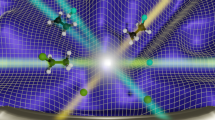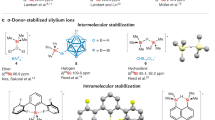Abstract
A SHORT time ago we showed in conjunction with Dr. C. S. Patel1 that the known facts concerning reactions of the type of the hydrolysis of ammonium cations (Reaction B) could be accommodated by the assumption of a dual mechanism: the reaction could be either bimolecular (B 2), or unimolecular (B1); for example: For a given organic cation, mechanism B 1 was expected to be favoured by a low nucleophilic activity in the reagent-anion, as for example towards the right-hand end of the anion series: On the other hand, for a given reagent-anion, mechanism B 1 should be favoured by constitutional changes in the organic cation, which confer upon the group Alk a greater tendency to pass into the cationic state, for example changes corresponding to passage towards the right in the aralphyl series,
This is a preview of subscription content, access via your institution
Access options
Subscribe to this journal
Receive 51 print issues and online access
$199.00 per year
only $3.90 per issue
Buy this article
- Purchase on Springer Link
- Instant access to full article PDF
Prices may be subject to local taxes which are calculated during checkout
Similar content being viewed by others
References
J. Chem. Soc., 526; 1933.
Cf. von Halban, Z. physikal. Chem, 67, 129; 1909.
J. Chem. Soc., 69, 75; 1933.
ibid., 258; 1933.
ibid., 2285; 1927.
J. Amer. Chem. Soc., 50, 1795; 1928.
Compare especially Segaller's experiments on phenolysis, J. Chem. Soc., 103, 1154, 1421; 1913.
Grant and Hinshelwood, loc. cit.
Author information
Authors and Affiliations
Rights and permissions
About this article
Cite this article
HUGHES, E., INGOLD, C. Dynamics and Mechanism of Aliphatic Substitutions. Nature 132, 933–934 (1933). https://doi.org/10.1038/132933b0
Issue Date:
DOI: https://doi.org/10.1038/132933b0
Comments
By submitting a comment you agree to abide by our Terms and Community Guidelines. If you find something abusive or that does not comply with our terms or guidelines please flag it as inappropriate.



